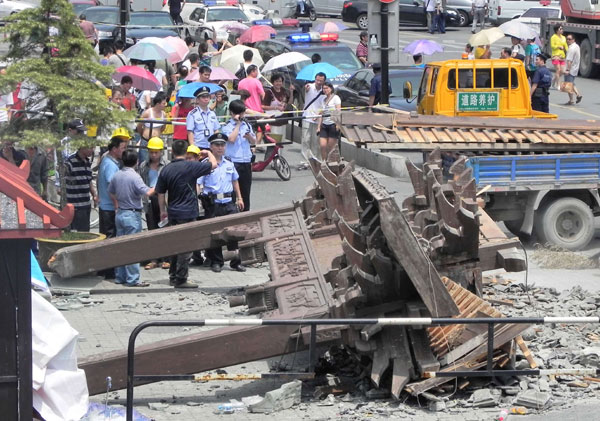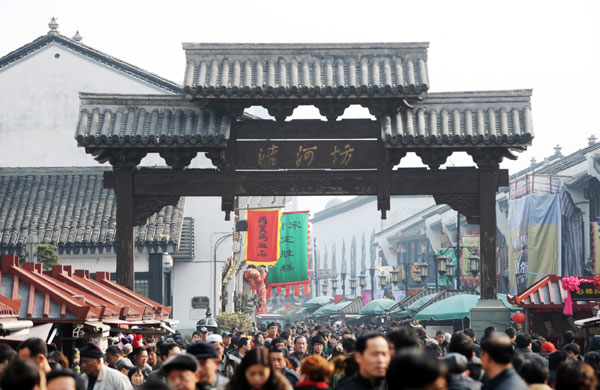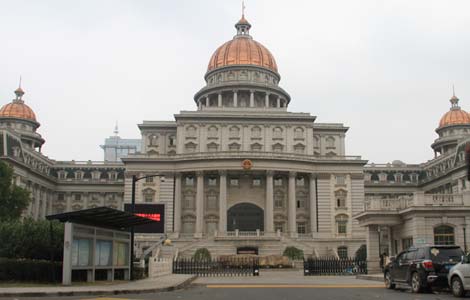
Accident on tourist-filled shopping street thought linked to heavy rainfall
Two people were killed and another one injured when an arch collapsed at a major tourism attraction of Qinghefang in Hangzhou, Zhejiang province, on Sunday morning.
 |
| Police officers block access to the arch that collapsed in Hangzhou, capital of Zhejiang province, on Sunday. Long Wei / for China Daily |
 |
| The arch, shown earlier this year, stood on a street built in the style of the Song Dynasty. Ju Huanzong / Xinhua |
The accident happened around 9:30 am, shortly after the traditional commercial street Qinghefang opened to the weekend tourists.
Lu Jin'e, a 58-year-old woman from Hubei province, died at the scene, and 62-year-old Jiang Guiying, a tourist from the Xinjiang Uygur autonomous region, died after being rushed to a hospital.
Qin Yang, 65, Lu's husband, broke both his legs and spent four hours in surgery at Hangzhou No 1 People's Hospital.
A doctor surnamed Yao said Qin was in a critical condition when he arrived at the hospital but his condition had been upgraded to stable after the surgery.
Qin's son, who wished not to be named, told China Daily that his father is likely to undergo more surgery. He said the government should explain to him how the tragedy could occur.
"I was only 10 meters away from the accident," said Zou Feng, a tourist from the nearby city of Jinhua.
"I heard an big crash from behind and it took a few minutes for the dust to disperse, and I didn't know what happened at first but few minutes later I realized that the arch collapsed.
"There was a woman who was under the ruins - I could tell she was a tourist because she held Hangzhou's city map in her hands, another 60-something man had his legs smashed."
Qinghefang Street, in the center of Hangzhou and close to the West Lake, was built in the style of the Song Dynasty (960-1279) when Hangzhou was the capital of the dynasty. However, the arch was not a historical building.
Local government said the arch was built in October 2001. Its base was made of reinforced concrete and it had a wood structure on top.
Local authorities said initial investigations indicated the collapse was caused by a fracture in the reinforced concrete and wood connections.
Further investigation is under way, a spokesman for the Shangcheng district government, which administers the street, said at a news conference on Sunday.
Some residents suggested the collapse could be linked to the recent heavy rainfalls brought by typhoon Haikui, which recently tore through the city.
"The timber structure itself is safe in terms of wind and earthquake resistance, however, its ability to prevent decay is poor, that's why blocks of stone are usually used as seats to stop direct contact between soil and wood," said Zhou Gang, an architecture professor at Xi'an University of Architecture and Technology.
"The traditional handicraft to bond stone and wood (for this kind of arch) needs to be exquisite because unlike structures built by bricks or concrete, arches can't resist high winds, not to mention typhoons," said Zhou, who specialized in civil engineering and housing safety issues.
Typhoon Haikui caused widespread flooding and disrupted traffic when it moved through Hangzhou last week.
Zhou Yiyi in Hangzhou contributed to this story.
shiyingying@chinadaily.com.cn







